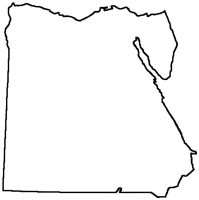
|
The Society of Folk Dance Historians (SFDH)
Ancient Egyptian Dance
[
Home |
About |
Encyclopedia | CLICK AN IMAGE TO ENLARGE |
 |
 In ancient Egypt, according to the scholars who have deciphered the writings of the scribes of those times, the sound "hbj" means "to be joyful," and the hieroglyph of that sound also means "dance." And indeed, dance was a very important part of Egyptian life, not only as a recreational and social form, but also very important in its many religious and symbolic meanings.
In ancient Egypt, according to the scholars who have deciphered the writings of the scribes of those times, the sound "hbj" means "to be joyful," and the hieroglyph of that sound also means "dance." And indeed, dance was a very important part of Egyptian life, not only as a recreational and social form, but also very important in its many religious and symbolic meanings.
There seems to have been a division, however, between the types of dance and who participated in the dances. The aristocratic, or "beautiful people" of the times of the pharaohs did not dance those in which he was joined with others – no peasant's dances, and apparently no equivalent of a couple Waltz, a Hora, or a Lancers. However, when taking ceremonial movements, rhythmic patterns, and the like into consideration, the nobility certainly had dances – and an example in the Cairo Museum shows King Tutankhamun with his wife, Ankhesenamun, performing a ritual dance in the presence of Ay (the penultimate pharaoh of Ancient Egypt's 18th dynasty) at the court in Thebes.
 All among the tombs and in the pyramids along the length of the Egyptian segments of the Nile River, in hieroglyph, picture, and carving, dancers along with musicians and singers have been discovered. One noted painting on the walls of a temple in Thebes (now in the British Museum) shows a group of singers, two musicians, and two dancers in what is apparently a very energetic dance, with the two women whirling around and around. A dance depicted on a wall painting in a tomb, dated close to 1900 BCE shows a trio of women in a dance with rather obvious fertility ritual motions that was seen by an explorer in the Valley of the Nile in the late 1800s CE done almost exactly the same way – a time spread of 3700 years!
All among the tombs and in the pyramids along the length of the Egyptian segments of the Nile River, in hieroglyph, picture, and carving, dancers along with musicians and singers have been discovered. One noted painting on the walls of a temple in Thebes (now in the British Museum) shows a group of singers, two musicians, and two dancers in what is apparently a very energetic dance, with the two women whirling around and around. A dance depicted on a wall painting in a tomb, dated close to 1900 BCE shows a trio of women in a dance with rather obvious fertility ritual motions that was seen by an explorer in the Valley of the Nile in the late 1800s CE done almost exactly the same way – a time spread of 3700 years!
The old Egyptian courts imported dwarfs or pygmies from the Land of Punt, far up the Nile River. These were generally black and were part of the household slaves. They probably originated in Rwanda. Such a dancing pygmy was a quite highly prized gift, and stood the donor in much a good grace with his King. The number three was a good omen in Egypt, and that number of figures turn up frequently in Nilotic dance pictures. One known example shows dancers holding dishes of wine or water as they gyrate without spilling it.
Dances were a very important part of the ceremonies at funerals. Going way back to the Fifth Dynasty on a tomb at Saggara, a group of women dancers in diaphanous dress are seen dancing with very high kicks, swinging their legs over the head of the deceased, in the manner of a Can-Can, and the very definite intention was an erotic performance in order to inspire him to return to life. This is on view at the Cairo Museum.
Animal dances were numerous, and the cow-goddess Hathor is seen on early Egyptian vases; harvest dances are also seen. This is probably the most common of early dances of the Valley of the Nile, for the harvest was the most important thing in the lives of the old Egyptians, rich or poor. Upon it, and the flooding of the Nile, life depended, and it was only natural that they celebrated those important occasions, as has about every culture on earth, even to the American Barn Dance following the harvesting.
Apparently there were professional women dancers in Egypt as far back as 4000 BCE prior to the earliest dynastic period. This may be seen on ancient vases of the period. From these dances, and handed down over the millenia, came the Egyptian dances for women of present times – the real ones, not the Hootchie-Kootchie, for all we know, in those days, they too had their mavericks. Masked dancers were also found in Egypt, again a feature that is found in some form or other all over the world, but especially favored at the Osiris festivals of the Middle Kindgom at Thebes around 2000 to 1800 BCE. Indeed, the ancient Egyptians of the Valley of the Nile had a dance to match almost anything we have with us today!
DOCUMENT
- Egypt, a country.
Printed in Folk Dance Scene, April 1978.
This page © 2018 by Ron Houston.
Please do not copy any part of this page without including this copyright notice.
Please do not copy small portions out of context.
Please do not copy large portions without permission from Ron Houston.